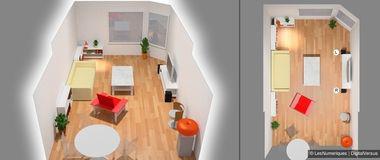Recommendations from international professional bodies (EBU/EBU 3276, AES AESTD1001 and SMPTE RP200).
Nothing like a good outline to avoid long speeches. You can already see some basic rules for placement and orientation in an optimal room. As a reminder, we are talking here about a 5.1 system composed at the front of the left (L), center (C) and right (R) speakers and, at the back, the rear-left (LS) and rear- right (RS). The subwoofer (subwoofer), also called LFE (Low Frequency Effect) channel, is not present on the diagram, because the speakers used are said to be full band, which means that they reproduce all the sounds audible by the human ear, from the most bass to the most treble, so there is no need for a subwoofer in such a configuration.

In this environment the loudspeakers should be placed at listening height at an angle of 0°, pointing towards the listening area and at the same distance from the listener. In the case of a video projector and a perforated screen, the central speaker can be placed behind the screen towards its lower half. If, however, the rear speakers cannot be at the right distance and above all closer to the listeners than the other speakers, it will be necessary to add a delay (delay) available in the amplifier settings. In addition, the loudspeakers must not be placed in a niche or cavity to avoid the resonance effects of certain frequencies. The reference listening level for a 5.1 listening system should be 85 dB(C).
Always in theory, but more subtle this time: in a multichannel configuration, unlike a stereophonic configuration, it is necessary to favor a room with absorbent materials placed everywhere to obtain a very short reverberation time and therefore avoid the effects that we find, exaggeratedly, in large rooms or empty corridors. This reverberation time must be less than 0.3 seconds and the first reflections of the room, more roughly the first moments of reverberation, must have a level less than 10 dB in the direct field (the signal that comes directly from the speakers to our ears). For the most mathematical and expert among you, you can find some small calculation tools in our box at the bottom of the page.
And now, practice!
Obviously, we are not in the enchanted world of the Care Bears and all these recommendations are very complicated to apply at home, between the tiled rooms, the windows, the different architectures and types of surfaces, the decoration, the layout preferences of each … Just know that there is no miracle solution and that you must above all appeal to your common sense and your ears. Also remember that the acoustics of a room is a very important factor in the final rendering, so think about carpets, curtains, filled bookcases... to better absorb the sound in your room, if you can't devote an entire room to the home movie theater.
Compared to the theory, the first changes are at the level of the architecture and the very surface of the part. Of course, it is difficult to really act at this level, which is why we will rely on several examples. Another factor, the layout and decoration of the room are elements to take into account and to which it will be necessary to adapt, but still trying to make some concessions. In addition, some amplifiers have a speaker calibration system using a dedicated protocol and a supplied microphone, more or less elaborate and precise depending on the model. These automatic systems are very practical for optimizing the sound reproduction when the placement is not perfect.








